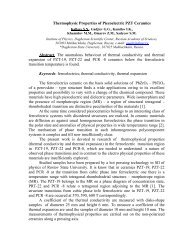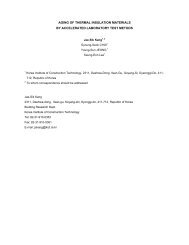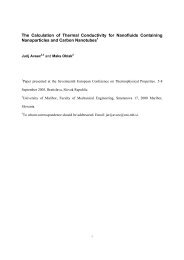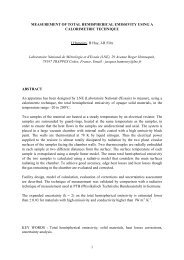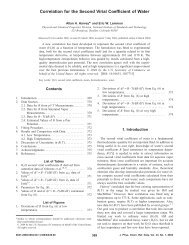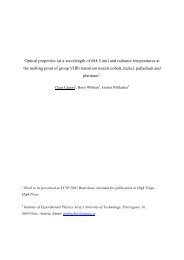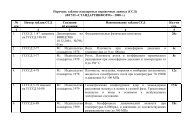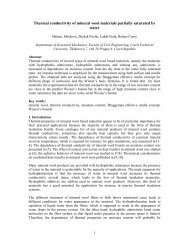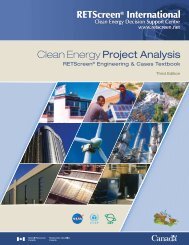Properties of alkali activated aluminosilicate ... - thermophysics.ru
Properties of alkali activated aluminosilicate ... - thermophysics.ru
Properties of alkali activated aluminosilicate ... - thermophysics.ru
You also want an ePaper? Increase the reach of your titles
YUMPU automatically turns print PDFs into web optimized ePapers that Google loves.
on the analysis <strong>of</strong> the temperature response <strong>of</strong> the analyzed material to heat flow impulses.<br />
The heat flow is induced by electrical heating using a resistor heater having a direct thermal<br />
contact with the surface <strong>of</strong> the sample. The measurements were done in dependence on<br />
moisture content.<br />
The specific heat capacity <strong>of</strong> dry materials was determined by the mixing calorimeter method<br />
in a water calorimeter. Calibration <strong>of</strong> the water calorimeter (tight Dewar flask) was done by<br />
warm water <strong>of</strong> similar heat capacity as was that <strong>of</strong> the sample. To determine the specific heat<br />
capacity <strong>of</strong> wet materials we used the mixing <strong>ru</strong>le. The content <strong>of</strong> moisture in porous material<br />
does not significantly change its volume. So, we can write for the volumetric specific heat<br />
capacity ρ wet c wet [Jm -3 K -1 ]<br />
ρ wet c wet = ρ dry c dry + ρ w c w w (4)<br />
ρ wet = ρ dry + ρ w w, (5)<br />
where ρ wet is the bulk density <strong>of</strong> the wet material, ρ dry the bulk density <strong>of</strong> the dry material, ρ w<br />
the density <strong>of</strong> water [kgm -3 ], w the moisture content by volume [m 3 m -3 ], c wet, c dry and c w the<br />
specific heat capacities <strong>of</strong> the wet material, the dry material and water, respectively, [Jkg -1 K -<br />
1 ].<br />
4. Experimental results and discussion<br />
Table 4 shows the basic characteristics <strong>of</strong> the studied <strong>aluminosilicate</strong> material determined by<br />
water vacuum saturation method after thermal load. The porosity began to increase<br />
significantly after heating to 600 0 C, achieved its maximum at 800 0 C, and at 1000 0 C and<br />
1200 0 C it was not changed significantly.<br />
Table 4 Basic properties <strong>of</strong> the studied material measured by water vacuum saturation method<br />
in dependence on thermal load<br />
Thermal load<br />
[ 0 C]<br />
Porosity<br />
[m 3 /m 3 ]<br />
Bulk density<br />
[kg/m 3 ]<br />
25 0.18 2170<br />
200 0.22 2100<br />
400 0.17 2170<br />
600 0.22 2070<br />
800 0.24 2030<br />
1000 0.24 2050<br />
1200 0.23 2050<br />
The values <strong>of</strong> porosity determined by mercury porosimetry shown in Table 5 were<br />
systematically lower than those determined by water vacuum saturation method. This is an<br />
expected result in general because the dimensions <strong>of</strong> the samples are significantly lower for<br />
mercury porosimetry so that big pores and cracks may not be included in the resulting<br />
porosity value. However, the basic trend concerning the increase <strong>of</strong> porosity with temperature<br />
was confirmed and the values <strong>of</strong> porosity determined by both methods were closer each other<br />
with the increase <strong>of</strong> temperature. The most dramatic increase in porosity was for mercury<br />
porosimetric measurements observed again at 600 0 C. The values <strong>of</strong> porosity at 1200 0 C were<br />
for water vacuum saturation method and mercury porosimetry the same. This indicates a<br />
4



